Aralia continentalis kitagawa Extract Attenuates the Fatigue Induced by Exhaustive Exercise through Inhibition of Oxidative Stress
Abstract
1. Introduction
2. Materials and Methods
2.1. Preparation of Aralia Extract
2.2. Ethics Statement
2.3. Animal Study Design
2.4. Forced Swimming Test
2.5. Quantification of Chlorogenic Acid in Aralia continentalis kitagawa (AC)
2.6. Analysis of Blood and Serum Parameters
2.7. Measurement of Oxidative Stress-Related Proteins
2.8. Western Blot Analysis
2.9. Statistical Analysis
3. Results
3.1. AC Extract Contains Chlorogenic Acid as an Active Component according to HPLC Analysis
3.2. AC Extract Increases Exercise Duration during Exhaustive Swimming
3.3. AC Extract Preserves Changes in Hemodynamic Parameter and Blood Ions after Exhaustive Swimming
3.4. AC Extract Attenuates Changes in Energy Metabolism-Related Serum Biomarkers after Exhaustive Swimming
3.5. AC Extract Ameliorates Metabolic Acidosis Due to Exhaustive Swimming
3.6. AC Extract Ameliorates Exhaustive Swimming-Induced Muscle Injury
3.7. AC Extract Suppresses Exhaustive Swimming-Induced Apoptosis
3.8. AC Extract Attenuates Oxidative Stress Induced by Exhaustive Swimming
4. Discussion
5. Conclusions
Author Contributions
Funding
Conflicts of Interest
References
- Ma, J.; Chen, H.; Liu, X.; Zhang, L.; Qiao, D. Exercise-Induced Fatigue Impairs Bidirectional Corticostriatal Synaptic Plasticity. Front. Cell. Neurosci. 2018, 12, 14. [Google Scholar] [CrossRef]
- Hong, R.; Sur, B.; Yeom, M.; Lee, B.; Kim, K.S.; Rodriguez, J.P.; Lee, S.; Kang, K.S.; Huh, C.K.; Lee, S.C.; et al. Anti-inflammatory and anti-arthritic effects of the ethanolic extract of Aralia continentalis Kitag. In IL-1β-stimulated human fibroblast-like synoviocytes and rodent models of polyarthritis and nociception. Phytomedicine 2018, 38, 45–56. [Google Scholar] [CrossRef] [PubMed]
- Sandi, C. Stress and cognition. Wiley Interdiscip. Rev. Cogn. Sci. 2013, 4, 245–261. [Google Scholar] [CrossRef] [PubMed]
- Gonzalez, J.T.; Fuchs, C.J.; Betts, J.A.; Van Loon, L.J.C. Liver glycogen metabolism during and after prolonged endurance-type exercise. Am. J. Physiol. Endocrinol. Metab. 2016, 311, E543–E553. [Google Scholar] [CrossRef] [PubMed]
- Stolecka-Warzecha, A.; Kaczmarczyk, T.; Żebrowska, A. Assessment of anaerobic endurance based on selected biochemical parameters in 400 M/400 M hurdles male athletes. Cent. Eur. J. Sport Sci. Med. 2016, 14, 101–110. [Google Scholar]
- Cairns, S.P. Lactic acid and exercise performance: Culprit or friend? Sports Med. 2006, 36, 279–291. [Google Scholar] [CrossRef]
- Rahman, M.; Lee, S.-J.; Mun, A.-R.; Adam, G.O.; Park, R.-M.; Kim, G.-B.; Kang, H.-S.; Kim, J.-S.; Kim, S.-J.; Kim, S.-Z. Relationships between blood Mg 2+ and energy metabolites/enzymes after acute exhaustive swimming exercise in rats. Biol. Trace Elem. Res. 2014, 161, 85–90. [Google Scholar] [CrossRef]
- You, L.; Zhao, M.; Regenstein, J.M.; Ren, J. In vitro antioxidant activity and in vivo anti-fatigue effect of loach (Misgurnus anguillicaudatus) peptides prepared by papain digestion. Food Chem. 2011, 124, 188–194. [Google Scholar] [CrossRef]
- Alessio, H.M. Exercise-induced oxidative stress. Med. Sci. Sports Exerc. 1993, 25, 218–224. [Google Scholar] [CrossRef]
- Simioni, C.; Zauli, G.; Martelli, A.M.; Vitale, M.; Sacchetti, G.; Gonelli, A.; Neri, L.M. Oxidative stress: Role of physical exercise and antioxidant nutraceuticals in adulthood and aging. Oncotarget 2018, 9, 17181–17198. [Google Scholar] [CrossRef]
- Kawamura, T.; Muraoka, I. Exercise-Induced Oxidative Stress and the Effects of Antioxidant Intake from a Physiological Viewpoint. Antioxidants 2018, 7, 119. [Google Scholar] [CrossRef] [PubMed]
- Jung, K.; Kim, I.-H.; Han, D. Effect of medicinal plant extracts on forced swimming capacity in mice. J. Ethnopharmacol. 2004, 93, 75–81. [Google Scholar] [CrossRef]
- Zhou, S.-S.; Jiang, J.-G. Anti-fatigue effects of active ingredients from traditional Chinese medicine: A review. Curr. Med. Chem. 2019, 26, 1833–1848. [Google Scholar] [CrossRef] [PubMed]
- Hwang, Y.P.; Choi, J.H.; Jeong, H.G. Protective effect of the Aralia continentalis root extract against carbon tetrachloride-induced hepatotoxicity in mice. Food Chem. Toxicol. 2009, 47, 75–81. [Google Scholar] [CrossRef] [PubMed]
- Okuyama, E.; Nishimura, S.; Yamazaki, M. Analgesic principles from Aralia cordata Thunb. Chem. Pharm. Bull. 1991, 39, 405–407. [Google Scholar] [CrossRef] [PubMed][Green Version]
- Oh, H.L.; Lee, D.-K.; Lim, H.; Lee, C.-H. HY253, a novel decahydrofluorene analog, from Aralia continentalis, induces cell cycle arrest at the G1 phase and cytochrome c-mediated apoptosis in human lung cancer A549 cells. J. Ethnopharmacol. 2010, 129, 135–139. [Google Scholar] [CrossRef] [PubMed]
- Lim, H.; Jung, H.A.; Choi, J.S.; Kim, Y.S.; Kang, S.S.; Kim, H.P. Anti-inflammatory activity of the constituents of the roots of Aralia continentalis. Arch. Pharmacal. Res. 2009, 32, 1237–1243. [Google Scholar] [CrossRef]
- Chung, C.-K.; Jung, M.-E. Ethanol fraction of Aralia elata Seemann enhances antioxidant activity and lowers serum lipids in rats when administered with benzo (α) pyrene. Biol. Pharm. Bull. 2003, 26, 1502–1504. [Google Scholar] [CrossRef]
- Yoon Jeong, H.; Hyun Moh, S.; Yang, Y.; Yu, T.; Oh, J.; Jeong, D.; Hyo Yoon, D.; Myun Park, K.; Lee, S.; Woong Kim, T.; et al. Src and Syk are targeted to an anti-inflammatory ethanol extract of Aralia continentalis. J. Ethnopharmacol. 2012, 143, 746–753. [Google Scholar] [CrossRef]
- Cardoso, P.C.D.S.; Rocha, C.; Leal, M.F.; Bahia, M.D.O.; Alcântara, D.D.F.A.; Dos Santos, R.A.; Gonçalves, N.D.S.; Ambrósio, S.R.; Cavalcanti, B.C.; Moreira-Nunes, C.A.; et al. Effect of diterpenoid kaurenoic acid on genotoxicity and cell cycle progression in gastric cancer cell lines. Biomed. Pharmacother. 2017, 89, 772–780. [Google Scholar] [CrossRef]
- Song, S.-J.; Nakamura, N.; Ma, C.-M.; Hattori, M.; Xu, S.-X. Five saponins from the root bark of Aralia elata. Phytochemistry 2001, 56, 491–497. [Google Scholar] [CrossRef]
- Yoshikawa, M.; Murakami, T.; Harada, E.; Murakami, N.; Yamahara, J.; Matsuda, H. Bioactive saponins and glycosides. VI. Elatosides A and B, potent inhibitors of ethanol absorption, from the bark of Aralia elata SEEM. (Araliaceae): The structure-requirement in oleanolic acid glucuronide-saponins for the inhibitory activity. Chem. Pharm. Bull. 1996, 44, 1915–1922. [Google Scholar] [CrossRef]
- Lee, J.E.; Sim, S.J.; Jeong, W.; Choi, C.W.; Kim, N.; Park, Y.; Kim, M.J.; Lee, D.; Hong, S.S. Diterpenoids and phenolic analogues from the roots of Aralia continentalis. J. Asian Nat. Prod. Res. 2020, 1–8. [Google Scholar] [CrossRef] [PubMed]
- Hyun, S.K.; Jung, H.A.; Min, B.S.; Jung, J.H.; Choi, J.S. Isolation of Phenolics, Nucleosides, Sacchardies and an Alkaloid from the root of Aralia cordata. Netural. Product. Sci. 2010, 16, 20–25. [Google Scholar]
- Liu, D.; Wang, H.; Zhang, Y.; Zhang, Z. Protective Effects of Chlorogenic Acid on Cerebral Ischemia/Reperfusion Injury Rats by Regulating Oxidative Stress-Related Nrf2 Pathway. Drug Des. Dev. Ther. 2020, 14, 51–60. [Google Scholar] [CrossRef] [PubMed]
- Choi, R.J.; Shin, E.M.; Jung, H.A.; Choi, J.S.; Kim, Y.S. Inhibitory effects of kaurenoic acid from Aralia continentalis on LPS-induced inflammatory response in RAW264.7 macrophages. Phytomedicine 2011, 18, 677–682. [Google Scholar] [CrossRef]
- Park, H.-J.; Hong, M.-S.; Lee, J.S.; Leem, K.-H.; Kim, C.-J.; Kim, J.-W.; Lim, S. Effects ofAralia continentalis on hyperalgesia with peripheral inflammation. Phytother. Res. 2005, 19, 511–513. [Google Scholar] [CrossRef]
- Brancaccio, P.; Maffulli, N.; Limongelli, F.M. Creatine kinase monitoring in sport medicine. Br. Med. Bull. 2007, 81–82, 209–230. [Google Scholar] [CrossRef]
- Swain, M.G. Fatigue in chronic disease. Clin. Sci. Lond. 2000, 99, 1–8. [Google Scholar] [CrossRef]
- Finsterer, J. Biomarkers of peripheral muscle fatigue during exercise. BMC Musculoskelet. Disord. 2012, 13, 218. [Google Scholar] [CrossRef]
- Clarkson, P.M.; Hubal, M.J. Exercise-induced muscle damage in humans. Am. J. Phys. Med. Rehabil. 2002, 81, S52–S69. [Google Scholar] [CrossRef] [PubMed]
- Baek, Y.-H.; Huh, J.-E.; Lee, J.-D.; Choi, D.-Y.; Park, D.-S. Effect of Aralia cordata extracts on cartilage protection and apoptosis inhibition. Biol. Pharm. Bull. 2006, 29, 1423–1430. [Google Scholar] [CrossRef] [PubMed]
- Tirapelli, C.R.; Ambrósio, S.R.; Coutinho, S.T.; de Oliveira, D.C.R.; da Costa, F.B.; de Oliveira, A.M. Pharmacological comparison of the vasorelaxant action displayed by kaurenoic acid and pimaradienoic acid. J. Pharm. Pharmacol. 2005, 57, 997–1004. [Google Scholar] [CrossRef] [PubMed]
- Cheng, W.-L.; Lin, T.-Y.; Tseng, Y.-H.; Chu, F.-H.; Chueh, P.J.; Kuo, Y.-H.; Wang, S.-Y. Inhibitory effect of human breast cancer cell proliferation via p21-mediated G1 cell cycle arrest by araliadiol isolated from Aralia cordata Thunb. Planta. Med. 2011, 77, 164–168. [Google Scholar] [CrossRef]
- Bol’shakova, I.V.; Lozovskaia, E.L.; Sapezhinskii, I.I. Antioxidant properties of a series of extracts from medicinal plants. Biofizika 1997, 42, 480–483. [Google Scholar]
- Hwang, Y.P.; Choi, J.H.; Han, E.H.; Kim, H.K.; Kang, S.K.; Chung, Y.C.; Jeong, H.G. Protective mechanisms of Aralia continentalis extract against tert-butyl hydroperoxide-induced hepatotoxicity: In vivo and in vitro studies. Food Chem. Toxicol. 2008, 46, 3512–3521. [Google Scholar] [CrossRef]
- Rahman, M.; Yang, D.K.; Kim, G.-B.; Lee, S.-J.; Kim, S.-J. Nigella sativa seed extract attenuates the fatigue induced by exhaustive swimming in rats. Biomed. Rep. 2017, 6, 468–474. [Google Scholar] [CrossRef][Green Version]
- Ament, W.; Verkerke, G.J. Exercise and fatigue. Sports Med. 2009, 39, 389–422. [Google Scholar] [CrossRef]
- Hultman, E.; Greenhaff, P.L. Skeletal muscle energy metabolism and fatigue during intense exercise in man. Sci. Prog. 1991, 75, 361–370. [Google Scholar]
- Westerblad, H.; Bruton, J.D.; Katz, A. Skeletal muscle: Energy metabolism, fiber types, fatigue and adaptability. Exp. Cell Res. 2010, 316, 3093–3099. [Google Scholar] [CrossRef]
- Lima, F.D.; Stamm, D.N.; Della-Pace, I.D.; Dobrachinski, F.; de Carvalho, N.R.; Royes, L.F.; Soares, F.A.; Rocha, J.B.; González-Gallego, J.; Bresciani, G. Swimming training induces liver mitochondrial adaptations to oxidative stress in rats submitted to repeated exhaustive swimming bouts. PLoS ONE 2013, 8, e55668. [Google Scholar] [CrossRef] [PubMed]
- McKenna, M.J.; Harmer, A.R.; Fraser, S.F.; Li, J.L. Effects of training on potassium, calcium and hydrogen ion regulation in skeletal muscle and blood during exercise. Acta Physiol. Scand. 1996, 156, 335–346. [Google Scholar] [CrossRef] [PubMed]
- Zhang, Y.; Xun, P.; Wang, R.; Mao, L.; He, K. Can Magnesium Enhance Exercise Performance? Nutrients 2017, 9, 946. [Google Scholar] [CrossRef] [PubMed]
- Nielsen, F.H.; Lukaski, H.C. Update on the relationship between magnesium and exercise. Magnes. Res. 2006, 19, 180–189. [Google Scholar]
- Karaki, H.; Urakawa, N.; Kutsky, P. Potassium-induced contraction in smooth muscle. J. Smooth Muscle Res. 1984, 20, 427–444. [Google Scholar] [CrossRef]
- McKenna, M.J.; Heigenhauser, G.J.F.; McKelvie, R.S.; MacDougall, J.D.; Jones, N.L. Sprint training enhances ionic regulation during intense exercise in men. J. Physiol. 1997, 501, 687–702. [Google Scholar] [CrossRef]
- Tang, Y.; Qi, R.; Wu, H.; Shi, W.; Xu, Y.; Li, M. Reduction of hemoglobin, not iron, inhibited maturation of red blood cells in male rats exposed to high intensity endurance exercises. J. Trace Elem. Med. Biol. 2019, 52, 263–269. [Google Scholar] [CrossRef]
- Slattery, K.; Bentley, D.; Coutts, A.J. The role of oxidative, inflammatory and neuroendocrinological systems during exercise stress in athletes: Implications of antioxidant supplementation on physiological adaptation during intensified physical training. Sports Med. 2015, 45, 453–471. [Google Scholar] [CrossRef]
- Powers, S.K.; Jackson, M.J. Exercise-induced oxidative stress: Cellular mechanisms and impact on muscle force production. Physiol. Rev. 2008, 88, 1243–1276. [Google Scholar] [CrossRef]
- Sun, Y.; Cui, D.; Zhang, Z.; Zhang, T.; Shi, J.; Jin, H.; Ge, Z.; Ji, L. Attenuated oxidative stress following acute exhaustive swimming exercise was accompanied with modified gene expression profiles of apoptosis in the skeletal muscle of mice. Oxi. Med. Cell. Longev. 2016, 1–8. [Google Scholar] [CrossRef]
- Marfe, G.; Manzi, V.; Tafani, M.; Pucci, B.; Gambacurta, A.; Russo, M.A.; Sinibaldi-Salimei, P. The modulation of sirtuins and apoptotic proteins in rats after exhaustive exercise. Open J. Mol. Integr. Physiol. 2012, 2, 65–74. [Google Scholar] [CrossRef][Green Version]
- Powers, S.K.; Hamilton, K. Antioxidants and exercise. Clin. Sports Med. 1999, 18, 525–536. [Google Scholar] [CrossRef]
- Leeuwenburgh, C.; Ji, L.L. Glutathione depletion in rested and exercised mice: Biochemical consequence and adaptation. Arch. Biochem. Biophys. 1995, 316, 941–949. [Google Scholar] [CrossRef] [PubMed]
- Li, X.D.; Sun, G.F.; Zhu, W.B.; Wang, Y.H. Effects of high intensity exhaustive exercise on SOD, MDA, and NO levels in rats with knee osteoarthritis. Genet. Mol. Res. 2015, 14, 12367–12376. [Google Scholar] [CrossRef]
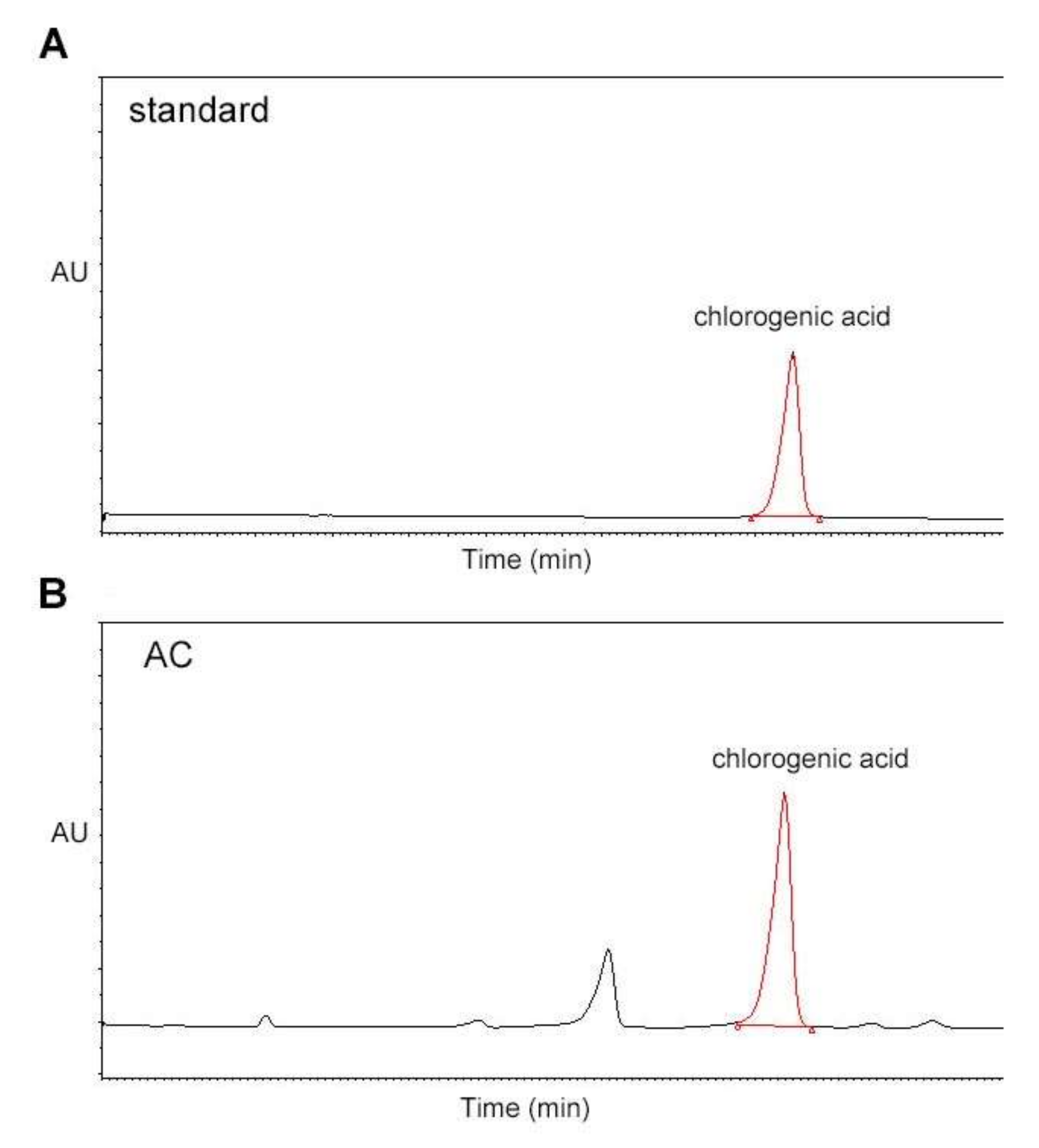
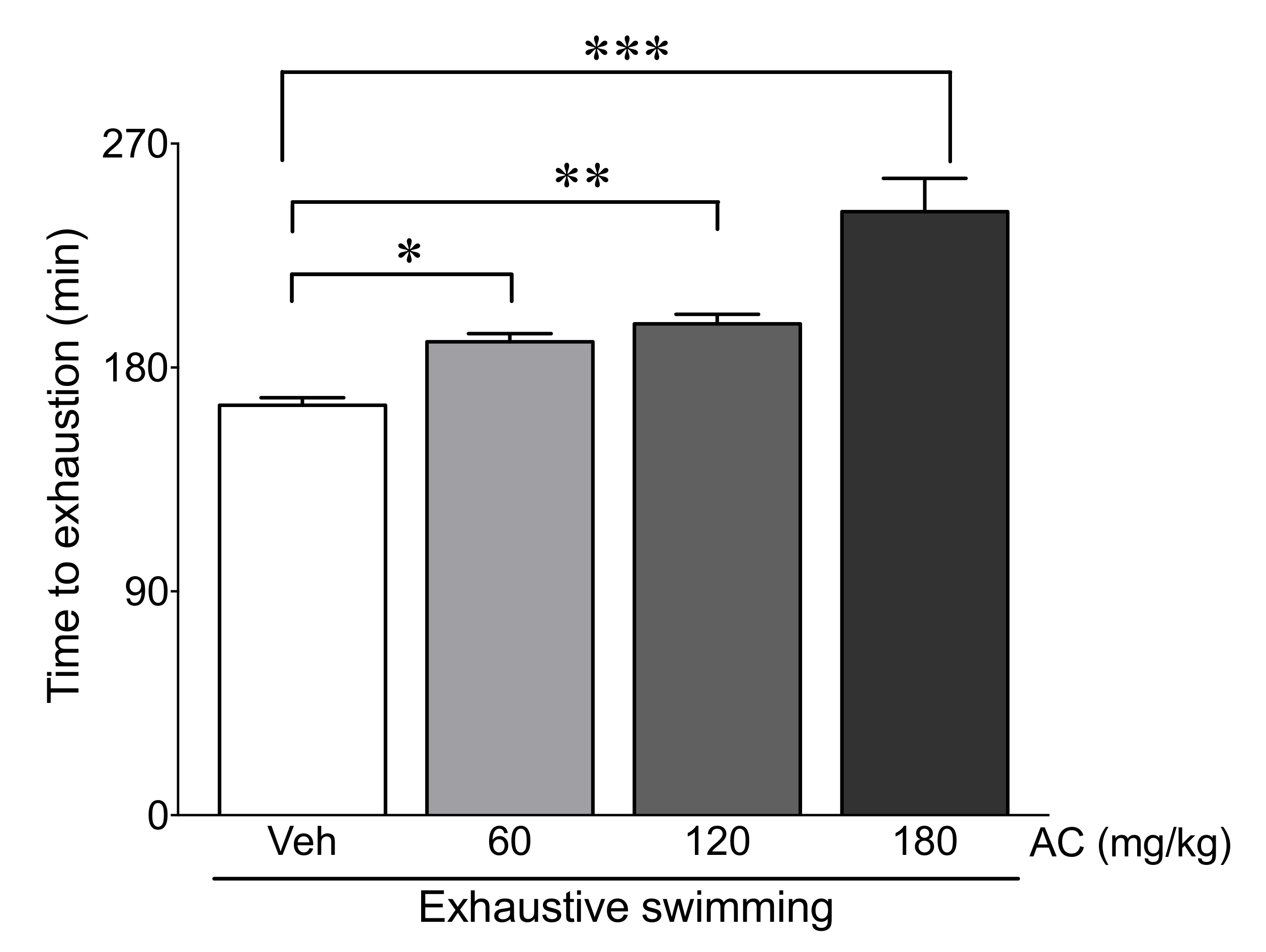
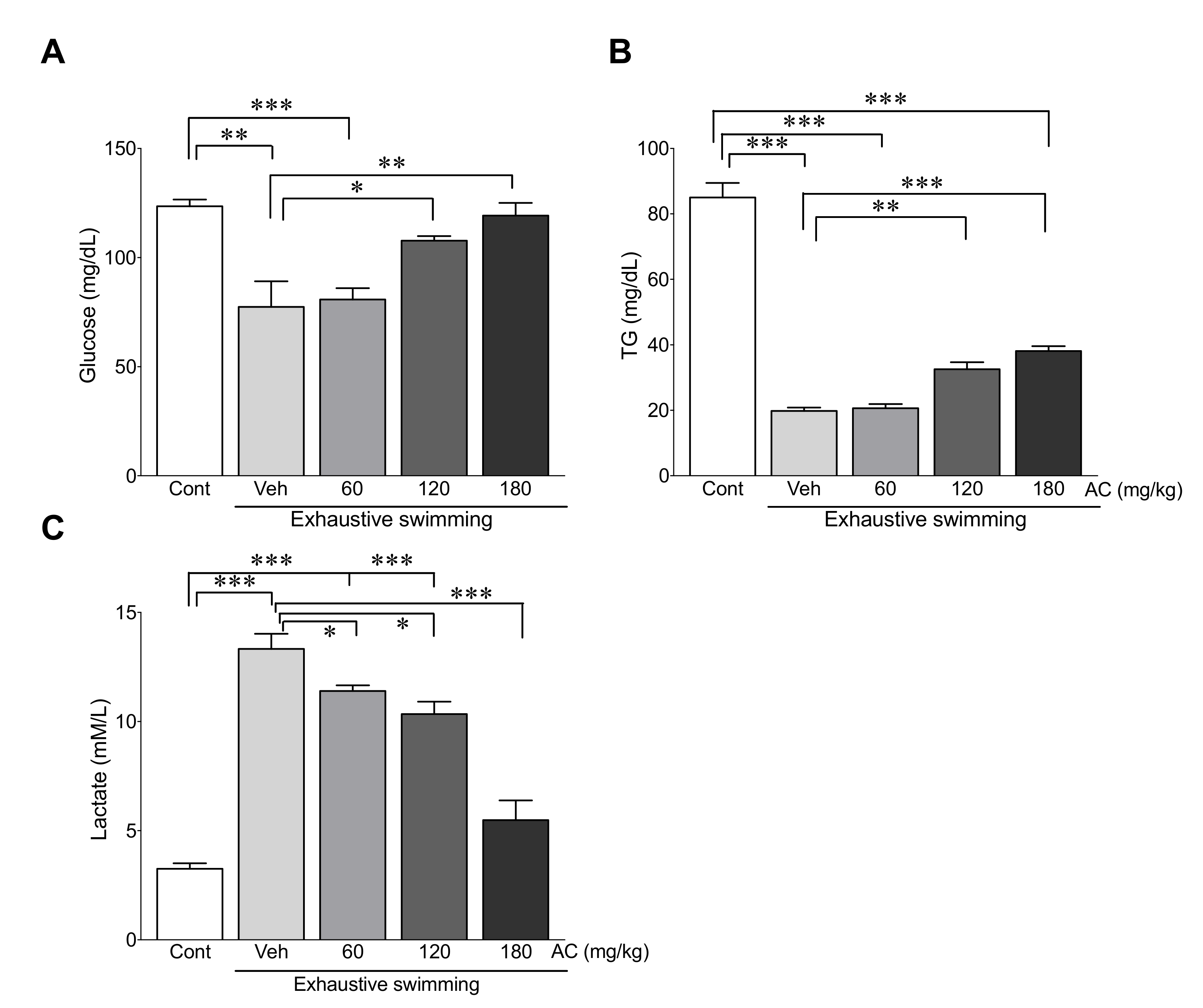
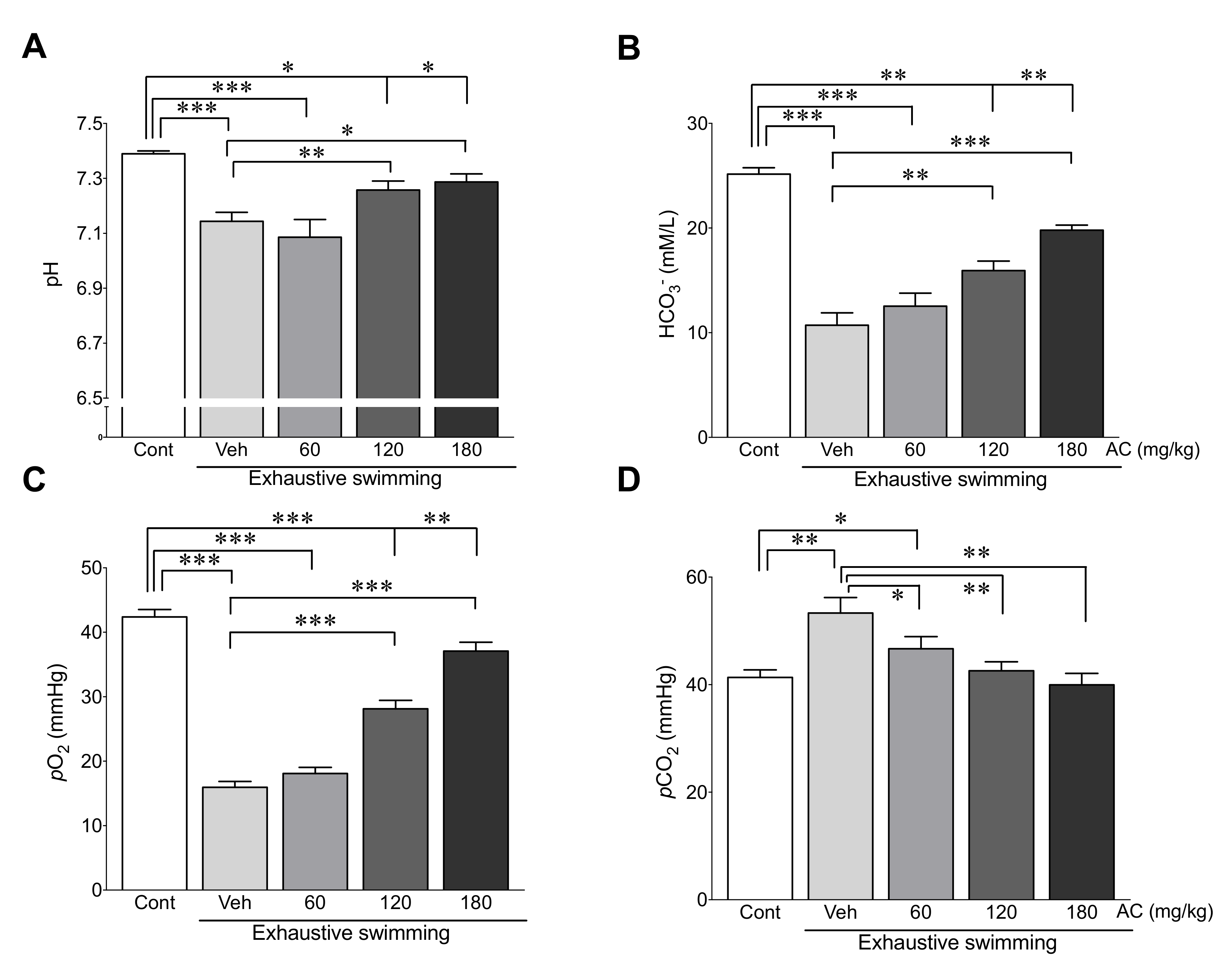
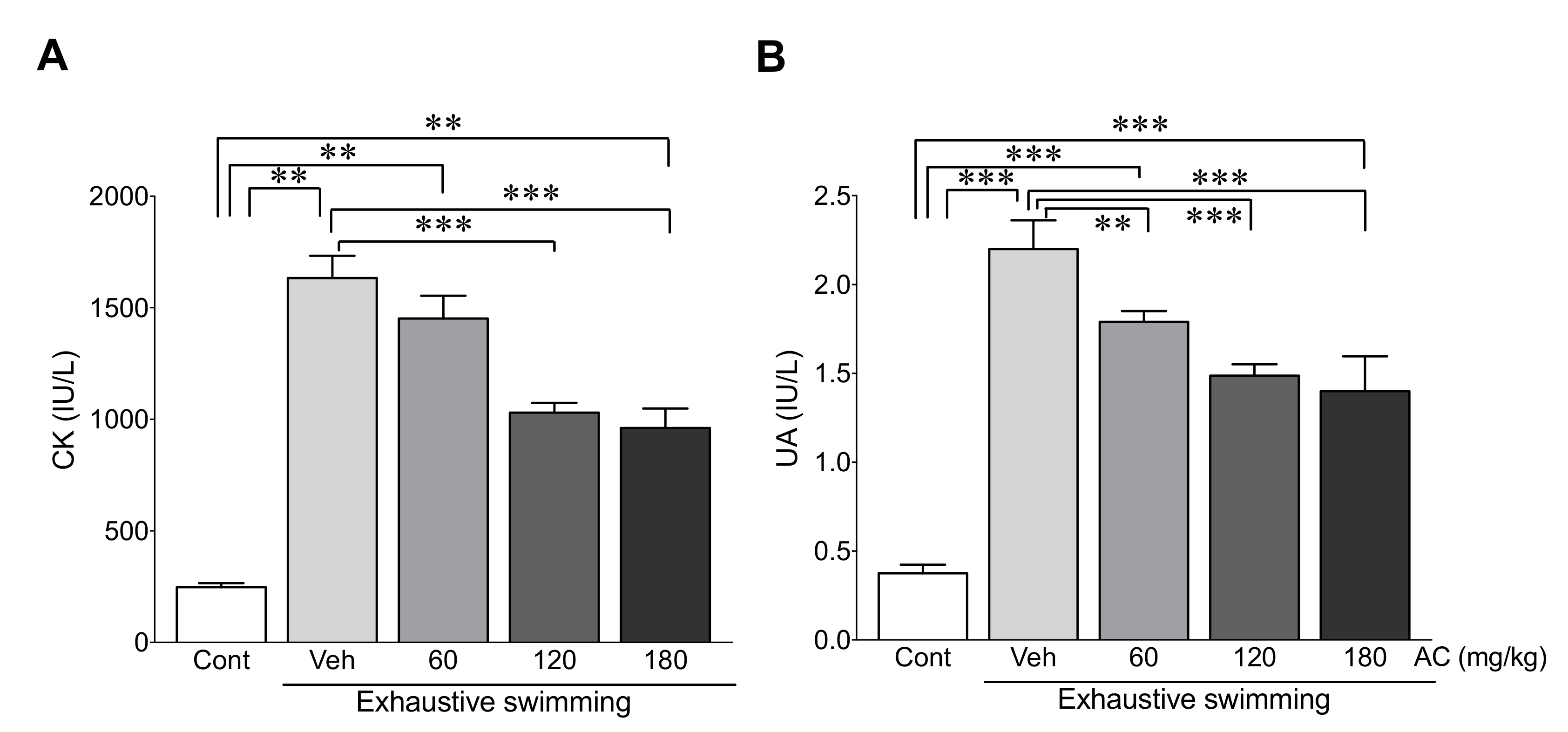
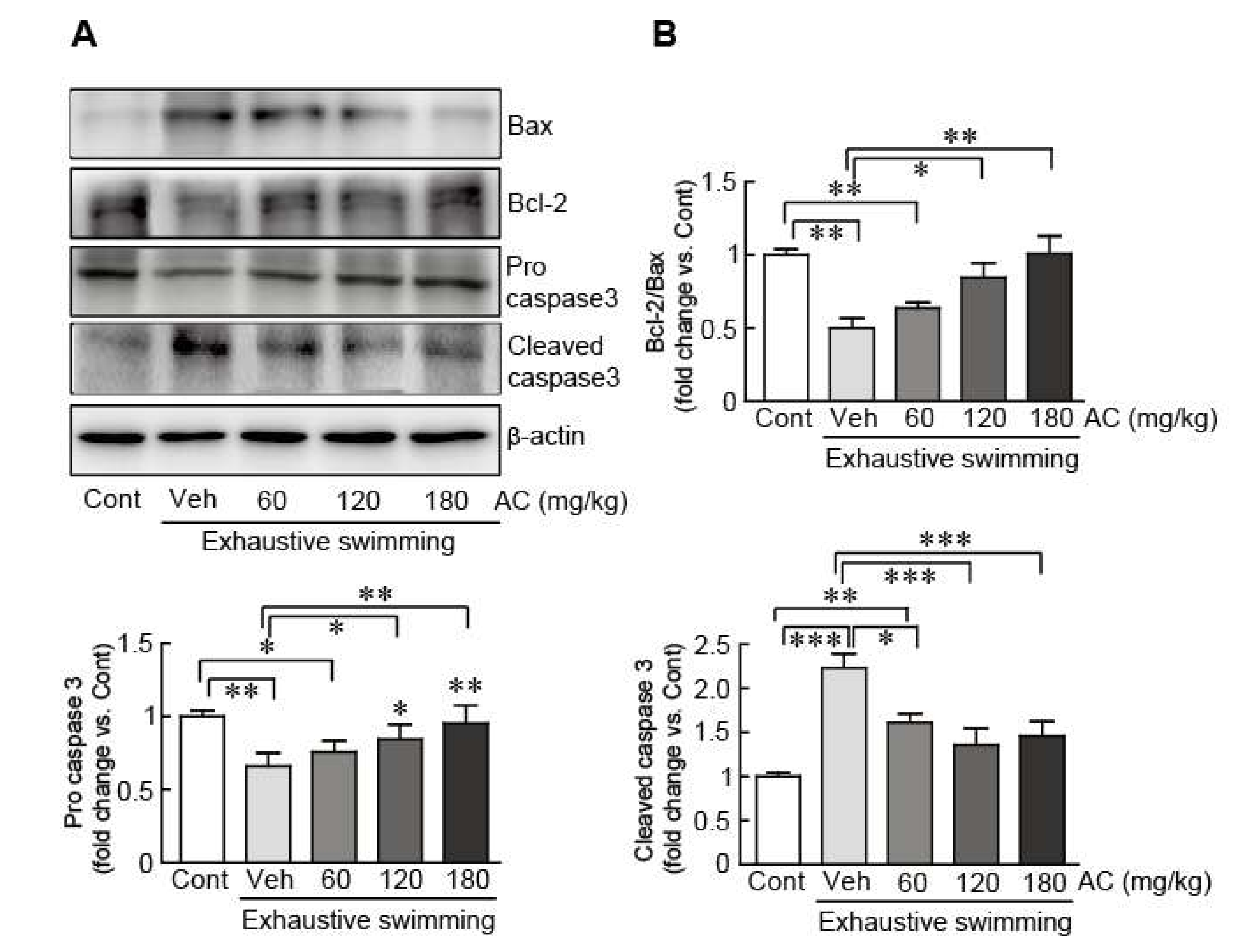
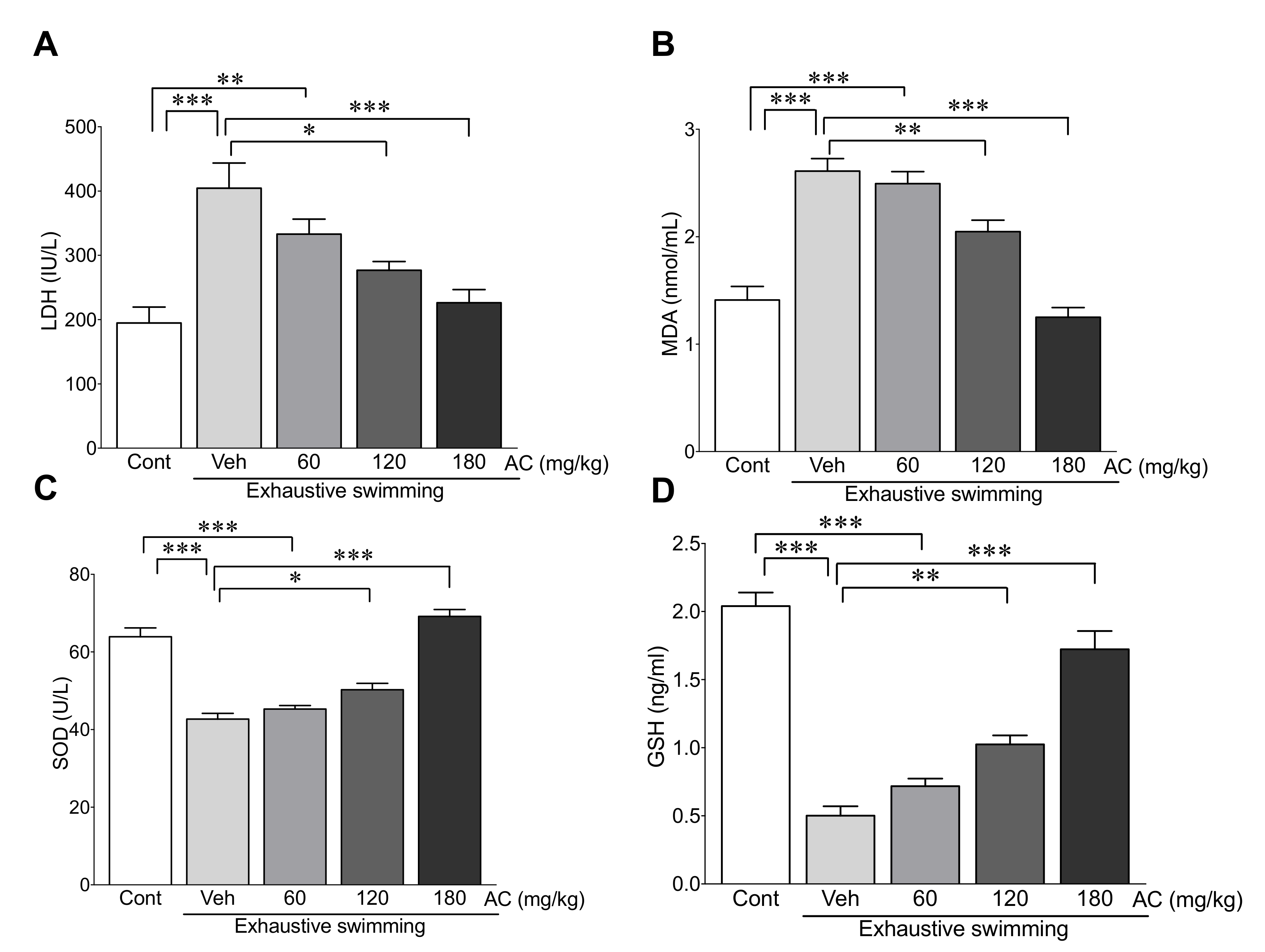
| Parameters | Exhaustive Swimming | ||||
|---|---|---|---|---|---|
| Cont | Veh | 60 | 120 | 180 AC (mg/kg) | |
| Hct (%) | 36.9 ± 0.6 | 43.1 ± 0.8 ### | 41.9 ± 0.6 ### | 39.6 ± 0.5 #,** | 37.2 ± 0.5 ** |
| Mg2+ (mmol/L) | 0.52 ± 0.08 | 0.62 ± 0.01 ### | 0.57 ± 0.01 # | 0.56 ± 0.02 * | 0.54 ± 0.01 ** |
| Ca2+ (mmol/L) | 1.25 ± 0.03 | 1.40 ± 0.01 ## | 1.34 ± 0.01 # | 1.31 ± 0.03 # | 1.29 ± 0.02 ** |
| Na+ (mmol/L) | 139.9 ± 1.0 | 146.1 ± 0.9 ## | 145.3 ± 1.0 ## | 141 ± 2.2 | 140.4 ± 0.7 * |
| K+ (mmol/L) | 4.5 ± 0.3 | 5.2 ± 0.2 ## | 4.9 ± 0.1 # | 4.6 ± 0.4 | 4.5 ± 0.1 * |
| BW (g) | 362.9 ± 7.4 | 345.6 ± 2.0 | 330.2 ± 3.4 ### | 329.3 ± 1.9 ### | 324.2 ± 3.2 ** |
© 2020 by the authors. Licensee MDPI, Basel, Switzerland. This article is an open access article distributed under the terms and conditions of the Creative Commons Attribution (CC BY) license (http://creativecommons.org/licenses/by/4.0/).
Share and Cite
Yang, D.K.; Lee, S.-J.; Adam, G.O.; Kim, S.-J. Aralia continentalis kitagawa Extract Attenuates the Fatigue Induced by Exhaustive Exercise through Inhibition of Oxidative Stress. Antioxidants 2020, 9, 379. https://doi.org/10.3390/antiox9050379
Yang DK, Lee S-J, Adam GO, Kim S-J. Aralia continentalis kitagawa Extract Attenuates the Fatigue Induced by Exhaustive Exercise through Inhibition of Oxidative Stress. Antioxidants. 2020; 9(5):379. https://doi.org/10.3390/antiox9050379
Chicago/Turabian StyleYang, Dong Kwon, Sei-Jin Lee, Gareeballah Osman Adam, and Shang-Jin Kim. 2020. "Aralia continentalis kitagawa Extract Attenuates the Fatigue Induced by Exhaustive Exercise through Inhibition of Oxidative Stress" Antioxidants 9, no. 5: 379. https://doi.org/10.3390/antiox9050379
APA StyleYang, D. K., Lee, S.-J., Adam, G. O., & Kim, S.-J. (2020). Aralia continentalis kitagawa Extract Attenuates the Fatigue Induced by Exhaustive Exercise through Inhibition of Oxidative Stress. Antioxidants, 9(5), 379. https://doi.org/10.3390/antiox9050379







